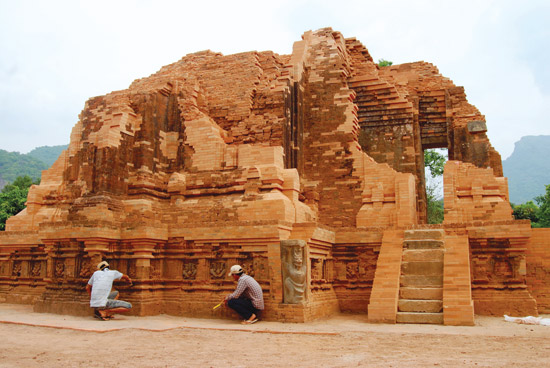(No.8, Vol.3, Sep 2013 Vietnam Heritage Magazine)

Temple G1 at My Son Sanctuary. Photo: Huynh Van My
The G group of temples at My Son World Heritage site, Quang Nam South-Central Province, was opened to the public in June 2013, after more than ten years of restoration.
Huynh Van My interviewes Professor Mauro Cucarzi, head of the project technical committee, Professor of Archaeology Patrizia Zolese, head of the archaeological unit, and the perseveration architect Mara Landoni, head of the on-site field team.
l Why did you prioritize the restoration of the Ggroup among the numerous damaged monuments in My Son?
P. Zolese, PhD:
‘Because the G group was not touched by the previous Polish-Vietnamese restoration team. The group also did not suffer any direct bombing. Despite heavy damage and collapse, the foundation and part of the body of the temples still remain intact. This group of monuments, furthermore, did not receive the attention of French experts in the past as did the A, B, C and F groups. We chose to restore the G group in order to apply archaeological restoration methods to create a model for future restorations of the Cham monuments.’
l The Cham temples are constructed out of bricks that seem to adhere themselves without the need for mortar. The bricks, moreover, allow for the carving of minute, meticulous patterns on them without crumbling into bits during the engraving process. How did the project come up with a restoration material with these properties?
M. Landoni, architect:
‘We researched the composition of the original Cham bricks in order to find a formula to produce bricks that are appropriate for the restoration of the G group temples and would not react with the heritage site’s existent bricks, and we succeeded in this task. Of course, we couldn’t make bricks that are entirely exactly like those of the ancient Cham people.’
‘As for the adhesive substance, we studied French, Polish, and Vietnamese documents. The Vietnamese and Polish specialists forwarded the hypothesis that the adhesive substance came from plants. We proceeded to take samples of the resin of the d?u rái (Dipterocarpus alatus) tree in the vicinity of My Son in order to do research and draw comparisons, and we found that it bears a relatively strong resemblance to the adhesive substance used by the ancient Cham people in the temples’ construction. It’s truly fascinating! We concluded that not only was there d?u rái resin in the adhesive used for temple construction, but also that there was even d?u rái resin inside the bricks. In short, the substance we put forward to be used in the restoration needed to satisfy three factors: It must be compatible with the original material, durable, and able to be extirpated from the original material should we find [its application] unsatisfactory [during construction] without affecting the original material. Nevertheless, the information in some newspaper that states that we discovered the actual adhesive substance used by the Cham people to build the temples is inaccurate.’
l Some Cham temples in the central region exposed a number of flaws after restoration and [their restoration] was even censured. As for the G group, this time around, I wonder…?

Architect Mara Landoni, second from right, and workers at work, My Son Sanctuary.
Photo: Huynh Van My
M. Cucarzi, PhD:
‘We applied international conservation standards. One principle we put forth was to minimalize reconstruction, should there be insufficient veritable evidence on the vestigial remains. And as another matter of principle, we needed to save the imperilled historical remains promptly, since without intervention, within one to five years, the remains would have collapsed due to grave damage. One more principle was that we respected the history of the remains. For instance, if a part of a temple had already collapsed, we would not reconstruct the fallen portion.’
A World Heritage site since 1999, the My Son Sanctuary, located in Quang Nam South-Central Province, amidst a hilly landscape, comprises eight groups of 71 monuments built throughout the 7th to 13th centuries, when My Son was the capital of the Champa Kingdom.
My Son was discovered by Henri Parmentier of the Archaeological Service of the Ecole Francaise d’Extreme Orient in 1898, who also directed numerous research and restoration campaigns in the area.
During the Vietnam War which ended in 1975, My Son was badly devastated by heavy bombing.
In 1982, the Vietnamese Ministry of Culture in collaboration with Polish experts started restoring several damaged monuments.
In 1999, a partnership was formed among the Vietnamese government, Italian government and UNESCO to restore My Son monuments. The G-group project is part of this partnership. (Source: UNESCO)

